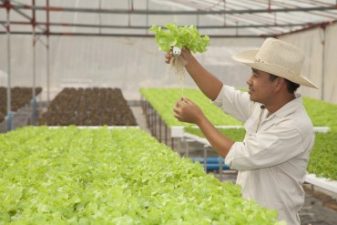Thailand is a great place to travel for comfort. There are glorious mangoes –– just picked and still holding warmth from the sun: they fall right into your hands or onto a plate of sticky rice. You will find that eating a great pad thai or going for a massage is as easy as breathing or going for a walk.
How can I describe Thailand quickly? Like your body is falling into the womb of nature –– it’s just a blessed place.
Traveling to Chiang Mai with the Family
It’s easy to travel to Thailand for comfort whether you are single or with a family. I have never met an easier place for that and have been there 5 times before my most recent trip. Thailand was there for me when I was freshly in love. It was there after a breakup. Thailand was there for me when I was pregnant with my first and it is where my second just started growing in my womb. We’d take them back there to play in the sand and jungle as infants and toddlers. We’d release turtles in their name. Send out lanterns to the sea with their hopes and dreams and blessings.
This spring after an isolating Covid period and with the kids at the perfect age for adventure traveling, we decided to take them away for family time and really invest in our experiences. This time we were going to go outside our comfort zone – we’d go outside the Thailand we knew: beaches, floating markets, temples, and beaches of Samui and Phuket. This time we would rely on my husband’s old memories from the early 90s to take us back to the mountains in the north.
Meeting the Akha People
Over the years my husband recalled traveling and meeting the Akha people three decades before. This was a trip to a paradise where you entered by elephant and came out leaving nothing behind. There was opium smoking, loads of smiles, and an innocence of mankind he experienced then.
He remembers it like a dream. And as an ecological ideal: Every scrap of paper, plastic – every bit – was saved and repurposed into something else.
We should go back, he says, but how?
I found Frans online, a fellow from Holland who is running an adventure tour company called Green Trails. He’d fallen in love with Thailand around the same time as my husband’s first trip. It was when Thailand was just opening to the world and the visitors couldn’t believe the bounty they’d discovered. Frans was easy to access and answered my query quickly: could you help us meet the Akha people?
Frans told me his company was providing accessible nature-based trips to Chiang Rai and Chiang Mai areas, along with itineraries that enable an extraordinary adventure in a short time. We could meet tribes people, even stay with them, but still have moments of comfort between the simple settings by staying in hotels during our stay. We had 6 days to spend in the north before our connecting flight back home. Frans jumped to help us plan a trip of a lifetime.
Authentic Family Experiences in Nature
Frans came back to us with a trip that would let us meet the various Hill Tribe people in a way that would be pleasant for everyone in our family, a girl 11, and boy 9 and two adults, one who can agree to hiking but who doesn’t love it much. Some people on the internet complain that these days visiting Hill Tribe people can feel exploitative like you are visiting a zoo. This is not at all what we encountered on our trip.
Frans arranged that we’d have an English speaking guide, Rung, who was from the region and who could communicate with the Hill Tribe people. Years’ long friendships and cooperation with Frans made our arrival welcoming without any suspicion. Thai people were still wearing masks at this time and many villages were no longer interested in meeting tourists, out of fear. But Frans knew who he could approach.
What to do along the way
We flew into Chiang Mai from Phuket and early the next day met Rung and Joe, our guide and driver. While driving to the areas of Chiang Rai and the hill tribe people we would have adventures along the way –– visiting avant garde museums, white water rafting, longboat sailing down rivers, visiting local markets and temples that are an art exhibit or spiritual exercise –– choose your own adventure. But it was planned and perfected by Frans, who over the years has learned what adventurous tourists would like to see. We were even able to add on adventures and make time for them if we saw something along the way that caught our eye.
But the blueprint of the trip was solid. Frans built us a trip that helped us experience the wild nature in Thailand that you would only find if you had a few months and a backpack. You could tell that the hill tribes he works with are coming from a long and trusting relationship that goes back decades, not years. For that, we were welcomed to these tiny villages even while the rest of Thailand was in semi lockdown wearing masks and keeping a safe distance.

Stocking up at a local market in Northern Thailand before we head to the Hill Tribes
Meeting the Palong People
The first encounter with the Palong tribe near Chiang Dao was meeting our guide and with him holding a machete we hiked from one Palong village Lahu to Pang How. We walked a few hours along trails he had carved out the day before, while he picked native plants showing us what they are and how they can be used in cooking. We got inside the jungle, his land, where agriculture and eco-tourism are the mainstays.
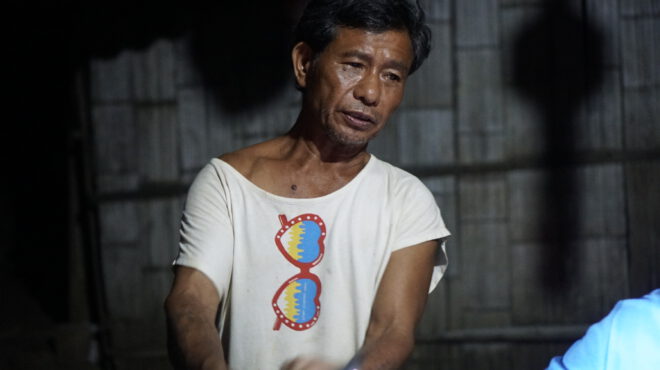
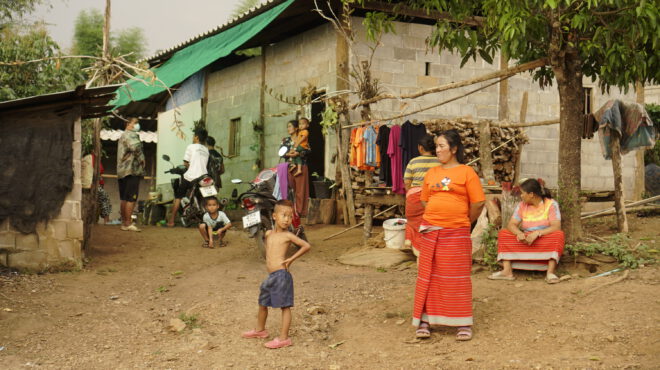
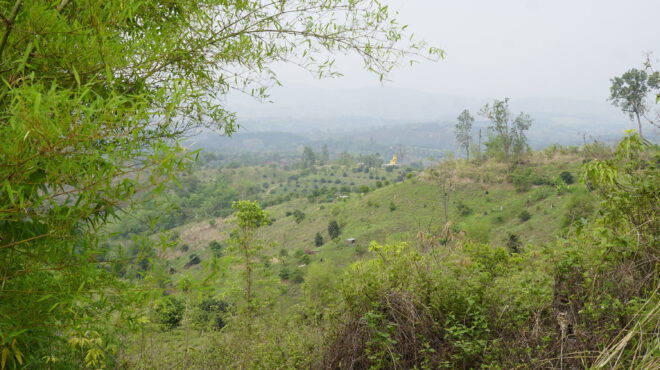
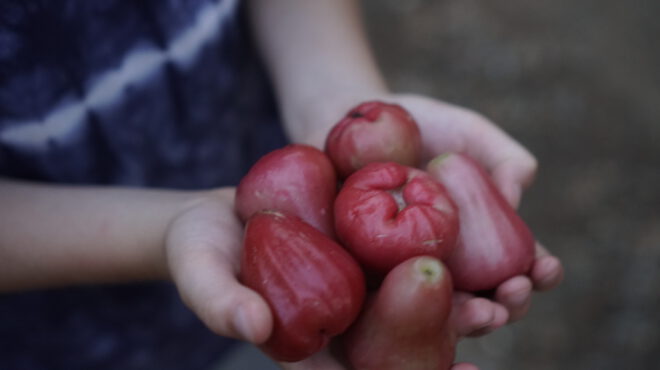
After pointing out plants such as wild rattan and ginger and making us walking sticks from bamboo, we entered the village. His family and extended tribe offered us shy hellos and greetings and after time my kids and their kids started to mingle, my daughter making a friend with a girl her age.
They picked papayas, fed the pigs and got accustomed to village life which is basic but comfortable. Outdoor toilets and sleeping in small bamboo huts is the accommodation. The floor is made from dirt, but it’s packed tight like it would be in a clay house.
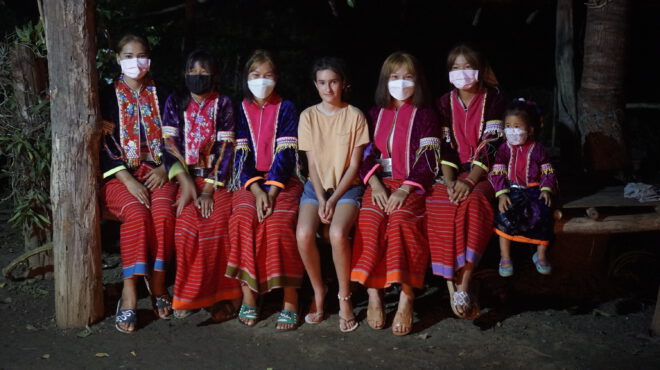
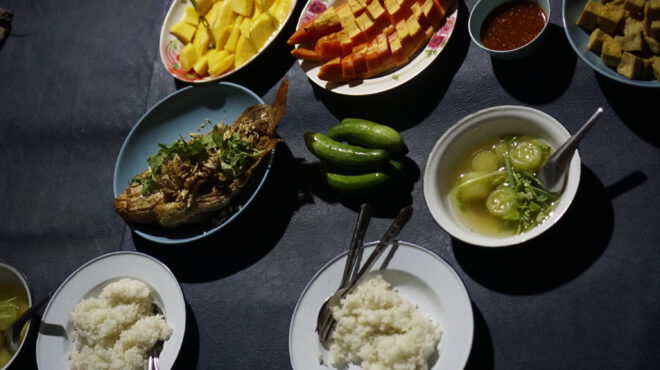
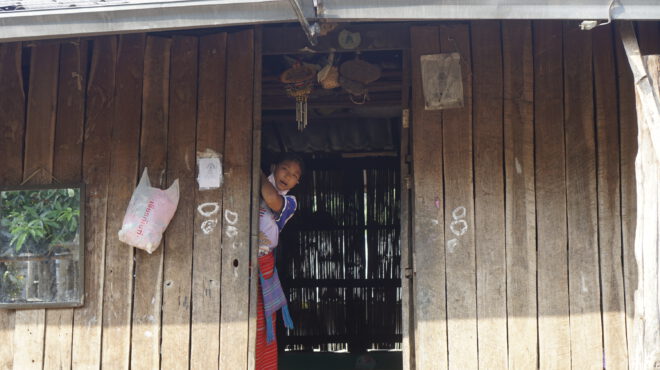
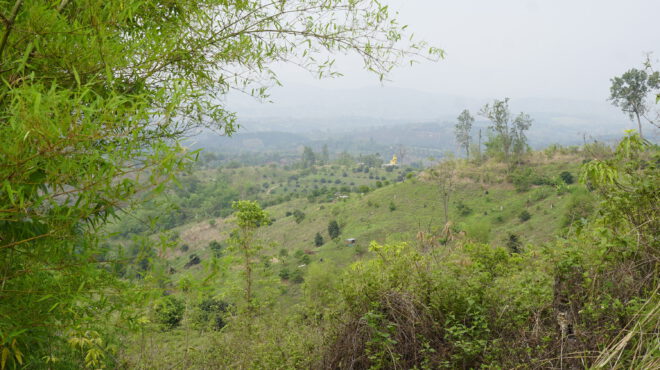
Some of the women taught us about the old ways of husking rice, and we were given a loom-weaving lesson –– my biggest take home is that they worked hard, sometimes days, to string together a meter of fabric that they assemble by hand.
Dinner was cooked by our host and our guide, and it was absolutely delicious and over-the-top. Our host and Rung worked for a couple of hours making sure it was perfect and exactly to our specifications: no seafood, meat or gluten. That’s a tall order in Thailand but our hosts arranged it with care.
At night the village girls of the village put on a show and my husband and our host took turns on a handmade instrument that kind of looked like a 3-string guitar. My family sang, we danced some and laughed our faces off at how the simplest, unusual encounters can make your soul expand wide. This is why we wanted to come here, It was for this. I was thanking Frans in my heart.
The Palong tribe, we learn, has its own colorful background. Not long ago they moved from Myanmar to Thailand and are distinguished by their rattan hoops and silver belt worn around the waist. The costume is a reminder of a bird, a mystical creature from which the Palong people are believed to be derived.
Meeting with the Akha People
An early morning with the dogs barking and roosters about, then we break-fasted and hiked around the village where Rung taught us about the village heart, the huja rawl. Up into the hills we visited the gardens of Sukhum, where fruits like mangoes grow. We trekked through to a Lahu village and then a Karen village –– and then started our drive to Thaton. We overnighted in a hotel and woke the next day to meet the Akha Tribe.
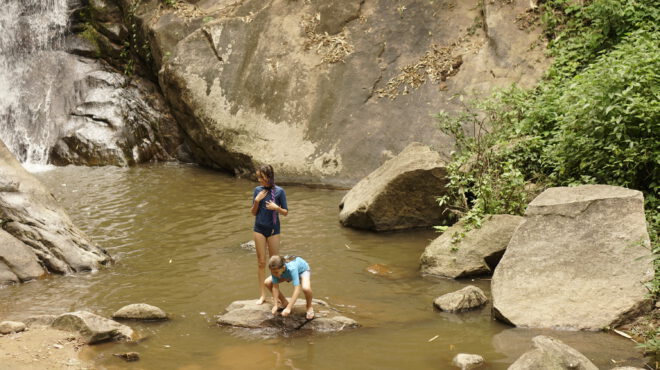
Along the way and cooling down in a cave temple – think ancient mystical cave where people seek immortality in Jitterbug Perfume? – we took a boat ride to a Lahu tribe village called Phatai.
We then continued to Chiang Rai and then to the Huay Mae Sai Waterfall where we met our local Akha guide from the village Ban Apha. When we arrived our guide Armue prepared our lunch, “jungle style” in a bamboo rod steamer he’d shucked from the forest. It felt like a Michelin Star experience. We dug in. High from the food and the waterfalls (only) we would learn that there is no more opium cultivation in the hills. That the tribespeople were eventually trained to manage agriculture and fruit trees to make a living. That living is now supplemented with homestays and eco tourism.
After lunch we hiked to the Akha village which was a pleasant walk through the forest and where our host and guide showed us native plants and told us folklore stories.
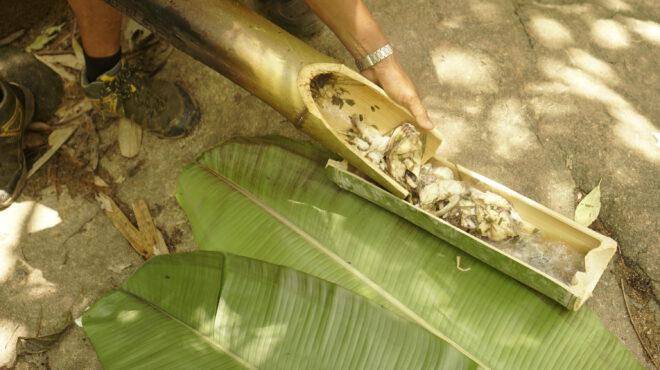
We arrived with a lot of excitement. Armue’s wife was stressed because the new baby goats weren’t herding in the right direction –– so my kids ran down to save the plants the goats were trying to eat. Have you ever held a bleating baby goat in your arms like a puppy? Our kids did this with wide smiles, while enjoying cats and kittens, chickens and a puppy near the hut.
Learning to cook authentic Hilltribe
We learned about the Akha clothes and were given a masterclass in cooking –– all suited to our dietary restrictions. We had fresh fish, soy protein, various soups, including a potato soup with red curry that I have recreated a few times since our trip. The highlight for me was cooking in the dark on the floor of the kitchen in an open pit fire.
I was just an observer but when the power went out and the rain came bolting onto our home-hut we had a taste of being Primal Man, but banded together in circumstance and ceremony. Our meal was magazine worthy and our beds were delightful, clean and private in a large bamboo hut resting on stilts on the edge of a jungle valley.
We arose to an endless feast again and were given a tour of the village and even peeks inside private homes. Saying goodbye was hard and I could have shed a tear because there is a true-ness and an authentic-ness to what we felt and experienced even though there was a financial transaction. It felt that there was joy for both sides in our meetings with the hill tribe people.
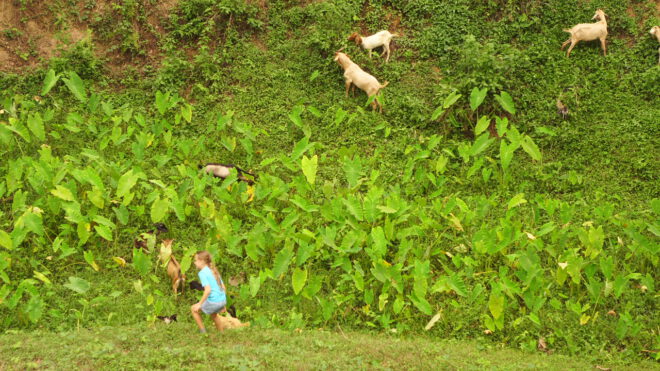
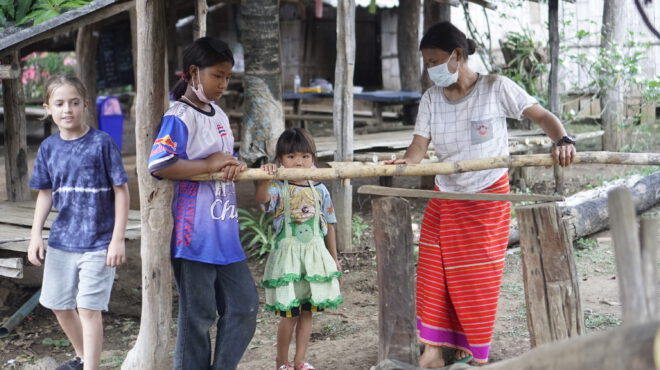
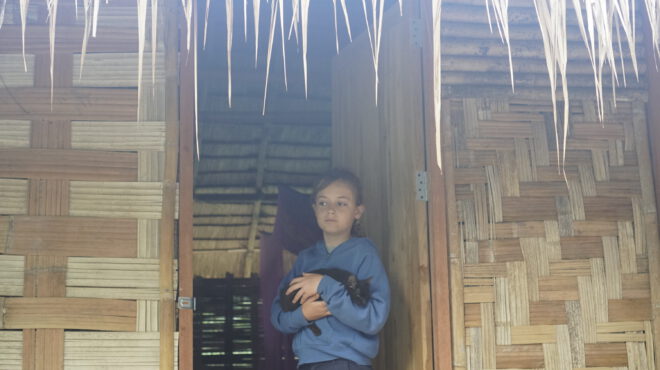
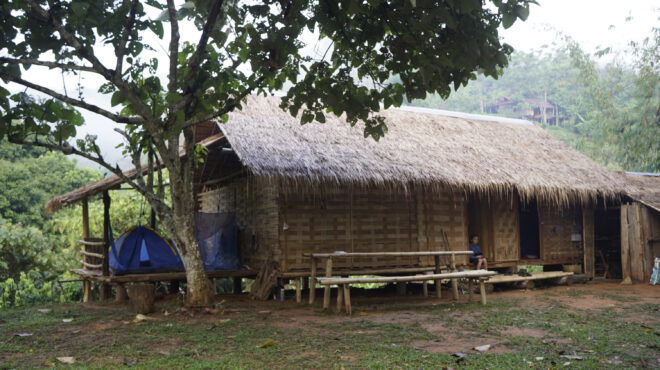
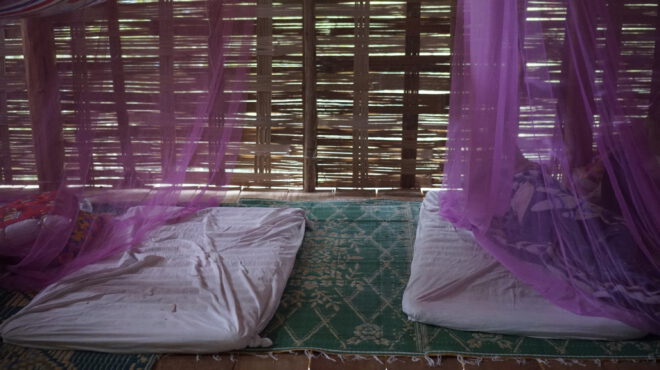
Maybe some of our innocence on both sides may be lost, but we can still feel innocent again if we reach out to meet new people and cultures.
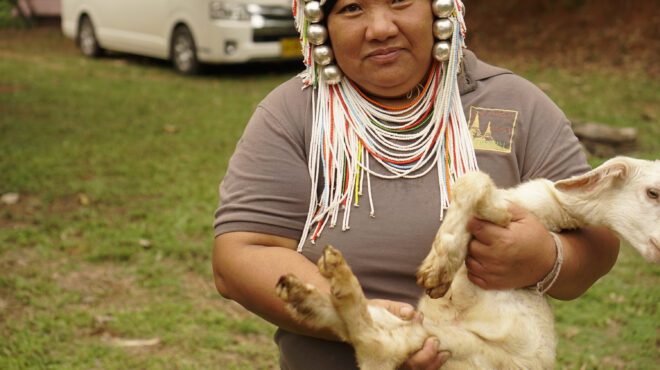
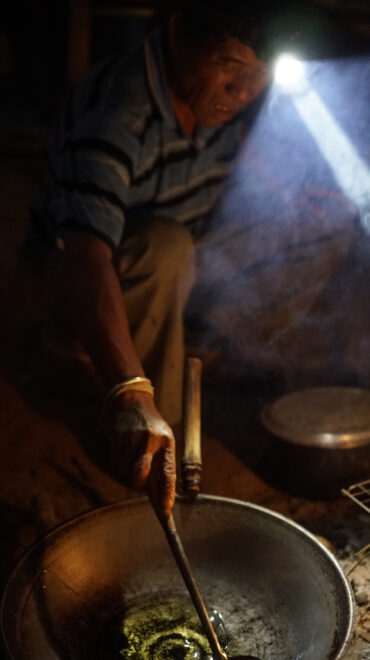
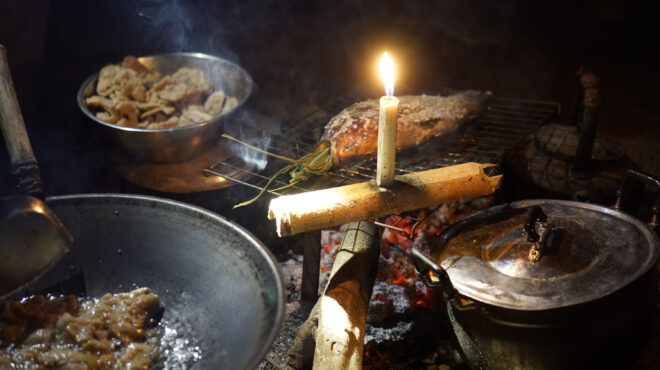
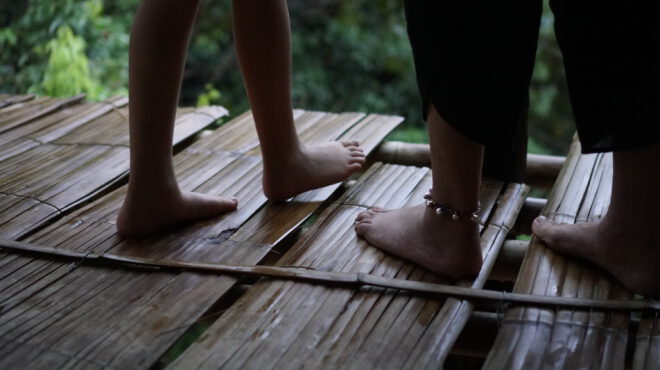
Our remainder of the trip didn’t fizzle out for a moment. We continued to a wonderful modern art museum. We visited iconic structures known by their colors: Blue, White, and Black. The Blue and White are temples, the Black House (Ban Dam) is a museum. White (wow) is for the Wat Huay Pla Kang temple, and its giant statue of Kuan Im, the goddess of Mercy. We took an elevator inside and I am still humming the chants of the monks and singers in my mind.
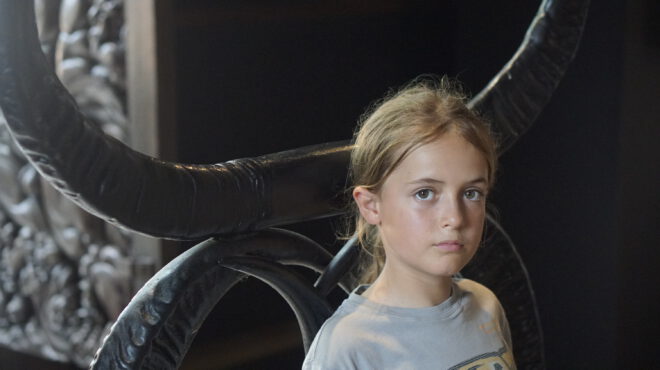
Over the 6 days with the adventuring in nature, riding down rivers in boats, waterfalls, trekking, caves, I couldn’t help but think of what an amazing trip this is for families but even more so dreamed of it as something my daughter could do with peers in a couple of years when she is a bit older. Eco-tourism, respectful meetings between the east and the west, jungle sports, great new cuisine, the safety and comfort of Thailand where the honey of nature is waiting for you to come and taste it.
“In general,” says Fran, owner of Green Trails, “we pay attention to tribal culture, languages, dress. One area, we have been doing well in are tours for schools and university groups. I want to develop this further because these trips are so rewarding for the students and the villagers.
“I want to focus on traditions, culture, and history as well as the preservation of heritage places and crafts,” he notes.


